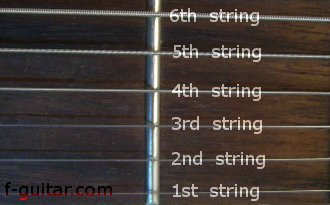Electric Guitar Diagram, Parts and other Essentials
On this page I put the essential information about parts of a guitar, finger and fret numbering, as well as brief explanation on guitar tablatures. This will help you map notes you'll see in guitar tab notation to actual locations of those notes on the fingerboard, where they are played. You'd better know this stuff to understand the following lessons.
Guitar structure

Fretting hand finger numbering

String Names
The strings on a guitar are called by either numbers or letter names:

- The thinnest is the 1st string.
- The thickest is the 6th one.

The high E is the thinnest and the low E is the thickest one.
Fret numbering on the fingerboard
When talking about guitar hardware, the word fret means one of the metal stripes inserted into the fingerboard. When it comes to guitar playing, the word fret usually means the space between the two metal stripes, not the metal stripe itself.
Guitar frets are referenced by numbers, the 1st one is the nearest to the headstock.

Using fret numbers and string numbers (or letter names) as coordinates to locate any note on the guitar fingerboard is much more straightforward than using conventional sheet music notation.
In case you didn't know yet, the music notation that uses the location method is called guitar tablature or shortly a guitar tab.
It is very easy to read and write guitar music by means of tabs, let's take a look at the following piece of guitar tab as an example:
1------------------- 2-------3-0--------- 3---2-5------------- 4------------------- 5------------------- 6-------------------
Here, there are 4 notes to be played:
- The 1st note is located at the 2nd fret on the 3rd string,
- the 2nd note is at the 5th fret on the same 3rd string,
- next, to play the 3rd note you go to the 2nd string and press the 3rd fret on it,
- the 4th note is play on the 2nd string also, but this time without pressing any fret on the fingerboard. (this is an open string).
The same tablature that uses letters for guitar strings looks like this:
e------------------- B-------3-0--------- G---2-5------------- D------------------- A------------------- E-------------------
The lowercase e letter, logically designates the thinnest string, the high E string, while the uppercase E stays for the thickest string (the low E).
Click here if you want to know more on reading guitar tabs
And by the way, to help you orientate more easily on the fingerboard, many guitar makers paint round marks at the 3rd, 5th, 7th, 9th, 12th, 15th, 17th, 19th, 21th, 24th frets (called fret markers). Some manufacturers use circles, triangles, trapezoids, or even paint flying birds (many PRS guitars) for the same purpose.
